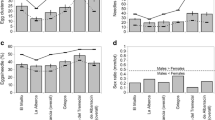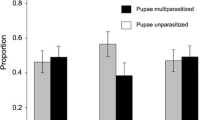Summary
Interspecific competition between the 3 principal larval parasitoids of the pine sawfly, Neodiprion sertifer, is of common occurrence when total larval parasitism, and hence multiple attack rates, are high. At the intrinsic level, the ectoparasitoid Exenterus abruptorius is superior to the 2 endoparasitoids, Lophyroplectus luteator and Lamachus eques, respectively, whereas L. luteator is superior to L. eques only. During mass outbreaks of the host competition between Exenterus and Lophyroplectus is most intense, whilst Lamachus fails to build up in the presence of its 2 competitors (Fig. 1). However, due to its superior host finding ability, Lamachus dominates in areas of low host densities where the 2 other species are less efficient (Table 1). L. luteator frequently sustains heavy losses in direct competition with E. abruptorius, but these can be largely compensated in the next generation because its fertility is about 5-times higher than that of Exenterus.
Similar content being viewed by others
References
Lenteren J van (1981) Host discrimination by parasitoids. In: Nordlund D, Jones J, Lewis W (eds) Semiochemicals: Their role in pest control. Wiley & Sons, New York
Martinek V (1972) Die Übervermehrung der roten Kiefernbuschhornblattwespe (Neodiprion sertifer Geoff.) und die Bedeutung ihrerer Parasiten in Knicholzbeständen Roz Českosl Akad Věd, Praha, p 115
Price P (1975) Reproductive strategies of parasitoids. In: Price P (ed) Evolutionary strategies of parasitic insects and mites. Plenum, New York
Pschorn-Walcher H (1967) Biology of the Ichneumonid parasites of Neodiprion sertifer Geoff. (Hym.: Diprionidae) in Europe. Techn Bull CIBC 8:7–52
Pschorn-Walcher H (1970) Studies on the biology and ecology of the alpine form of Neodiprion sertifer (Geoff.) (Hym.: Diprionidae) in the Swiss Alps. Z angew Ent 66:64–83
Pschorn-Walcher H (1973) Die Parasiten der gesellig lebenden Kiefern-Buschhornblattwespen (Familie Diprionidae) als Beispiel für Konkurrenz und Koexistenz in multiplen Parasit-Wirt-Komplexen. Verh Deutsch Zool Ges 66. Jahresvers 136–145
Pschorn-Walcher H (1982) Unterordnung Symphyta, Pflanzenwespen. In: Schwenke W (ed) Die Forstschädlinge Europas 4, Parey, Berlin
Pschorn-Walcher H (1985) Konkurrenz und Mannigfaltigkeit bei Parasitoiden. Z zool System Evol Forsch 23:286–298
Zwölfer H (1979) Strategies and counterstrategies in insect population systems competing for space and food in flower heads and plant galls. Fortschr Zool 25:331–353
Author information
Authors and Affiliations
Rights and permissions
About this article
Cite this article
Pschorn-Walcher, H. Interspecific competition between the principal larval parasitoids of the pine sawfly, Neodiprion sertifer (Geoff.) (Hym.: Diprionidae). Oecologia 73, 621–625 (1987). https://doi.org/10.1007/BF00379426
Received:
Issue Date:
DOI: https://doi.org/10.1007/BF00379426




